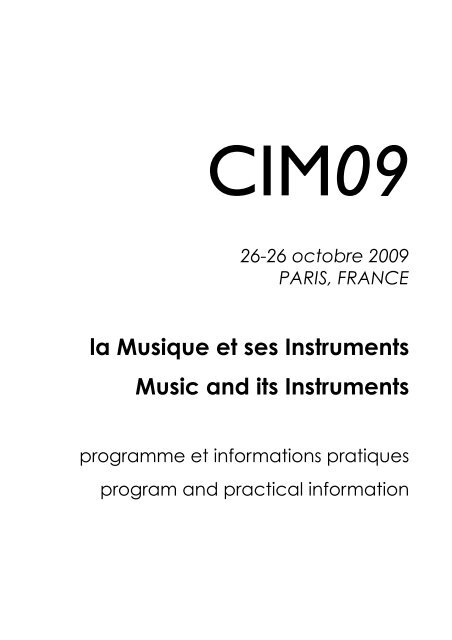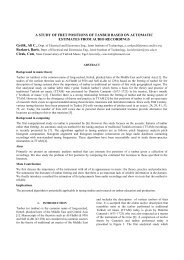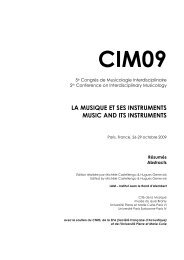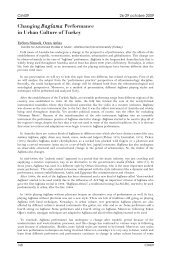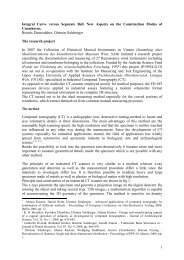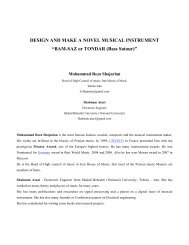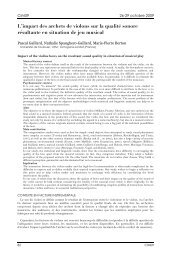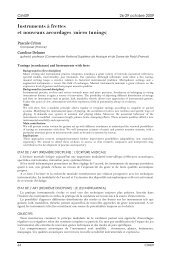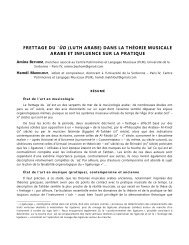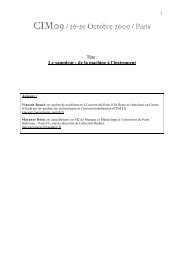programme détaillé - 5th Conference on Interdisciplinary Musicology
programme détaillé - 5th Conference on Interdisciplinary Musicology
programme détaillé - 5th Conference on Interdisciplinary Musicology
You also want an ePaper? Increase the reach of your titles
YUMPU automatically turns print PDFs into web optimized ePapers that Google loves.
CIM09<br />
26-26 octobre 2009<br />
PARIS, FRANCE<br />
la Musique et ses Instruments<br />
Music and its Instruments<br />
<str<strong>on</strong>g>programme</str<strong>on</strong>g> et informati<strong>on</strong>s pratiques<br />
program and practical informati<strong>on</strong>
INTRODUCTION<br />
Le C<strong>on</strong>grès Interdisciplinaire de Musicologie (CIM) a pour objectif de favoriser l’existence<br />
d’interacti<strong>on</strong>s c<strong>on</strong>structives entre la musicologie et les autres disciplines autour d’objets<br />
d’études communs, qu’il s’agisse des sciences de l’Homme (ethnologie, histoire, linguistique,<br />
psychologie, sociologie…), des sciences physiques (acoustique, informatique, physiologie…)<br />
que de réflexi<strong>on</strong>s issues de pratiques musicales expertes (interprétati<strong>on</strong>, analyse musicale,<br />
enseignement, facture instrumentale…). L'objet du CIM est de promouvoir les collaborati<strong>on</strong>s<br />
entre sciences et humanités, entre théorie et pratique, et ainsi de favoriser les échanges créatifs<br />
entre disciplines.<br />
LA MUSIQUE ET SES INSTRUMENTS<br />
Dans le prol<strong>on</strong>gement des thèmes précédents du CIM (timbre, chant, structure musicale), le<br />
CIM09 aborde la questi<strong>on</strong> des rapports que la musique entretient avec les instruments qui<br />
servent à la produire.<br />
Comment une culture et sa musique s<strong>on</strong>t-elles liées à certains univers instrumentaux Quelles<br />
influences mutuelles s'exercent entre des instruments et des répertoires Comment des<br />
instruments, parfois créés en vue d'une musique particulière, suscitent-ils d’autres musiques Ou,<br />
inversement, que se passe-t-il quand il faut rec<strong>on</strong>struire des instruments pour faire revivre une<br />
musique <br />
Voici quelques sujets qui, parmi d'autres, s'inscrivent dans la thématique : La musique et ses<br />
instruments :<br />
• Relati<strong>on</strong>s entre musiques, lieux, c<strong>on</strong>textes et instruments<br />
• Liens entre l’histoire de la facture instrumentale et l’histoire des langages musicaux<br />
• Transcripti<strong>on</strong> instrumentale et transformati<strong>on</strong>s musicales<br />
• Nouveaux instruments et nouveaux gestes dans la musique c<strong>on</strong>temporaine<br />
• Le compositeur et l’interprète face à l’instrument<br />
• Virtuosité, erg<strong>on</strong>omie et performance instrumentale<br />
• Instruments savants, instruments populaires <br />
• Rec<strong>on</strong>stituti<strong>on</strong>, restaurati<strong>on</strong> d'instruments : quel lien avec la musicologie historique <br />
• Transmissi<strong>on</strong> des savoirs techniques<br />
• Liens entre mécanique et acoustique des instruments et c<strong>on</strong>séquences dans l’écriture<br />
musicale<br />
• Instruments, systèmes de hauteurs et accordages<br />
• Déclin, dispariti<strong>on</strong> et renaissance d’instruments (c<strong>on</strong>traintes musicales, sociales,<br />
éc<strong>on</strong>omiques)<br />
• Histoire des savoir-faire techniques dans la c<strong>on</strong>cepti<strong>on</strong> et le jeu des instruments<br />
• Art et instruments
INTRODUCTION<br />
The <str<strong>on</strong>g>C<strong>on</strong>ference</str<strong>on</strong>g> <strong>on</strong> <strong>Interdisciplinary</strong> <strong>Musicology</strong> is a forum for c<strong>on</strong>structive interacti<strong>on</strong> am<strong>on</strong>g all<br />
musically and musicologically relevant disciplines, including acoustics, aesthetics,<br />
anthropology, archeology, art history and theory, biology, compositi<strong>on</strong>, computing, cultural<br />
studies, educati<strong>on</strong>, ethnology, history, linguistics, literary studies, mathematics, medicine, music<br />
theory and analysis, percepti<strong>on</strong>, performance, philosophy, physiology, prehistory,<br />
psychoacoustics, psychology, semiotics, sociology, statistics, and therapy. CIM especially<br />
promotes collaborati<strong>on</strong>s between sciences and humanities, between theory and practice, as<br />
well as interdisciplinary combinati<strong>on</strong>s that are new, unusual, creative, or otherwise especially<br />
promising.<br />
MUSIC AND ITS INSTRUMENTS<br />
CIM09 will focus <strong>on</strong> relati<strong>on</strong>ships between music and the instruments used for its producti<strong>on</strong>.<br />
How is the music of a given culture determined or influenced by the nature of its musical<br />
instruments How do instruments influence repertoires How are instruments that have been<br />
developed in the c<strong>on</strong>text of given musical styles used in new styles C<strong>on</strong>versely, what issues<br />
arise when old instruments are revived, or new instruments adapted, for the performance of<br />
early music<br />
The following topic areas illustrate the depth and scope of the c<strong>on</strong>ference theme:<br />
• Relati<strong>on</strong>s between music, places, c<strong>on</strong>texts and instruments<br />
• Historical links between musical style and instrument c<strong>on</strong>structi<strong>on</strong>/acoustics<br />
• Historical and acoustical aspects of the recovery and restorati<strong>on</strong> of early instruments<br />
• New instruments and new gestures in c<strong>on</strong>temporary music<br />
• Decline, loss and rebirth of instruments: musical, social, ec<strong>on</strong>omic and cultural c<strong>on</strong>straints<br />
and implicati<strong>on</strong>s<br />
• Erg<strong>on</strong>omics and virtuosity in instrumental performance<br />
• Physical, psychological and sociological interacti<strong>on</strong>s am<strong>on</strong>g composers, performers,<br />
instruments and audience<br />
• Compositi<strong>on</strong>al c<strong>on</strong>sequences of links between the mechanical and acoustic properties of<br />
instruments<br />
• Instruments, temperaments and tunings<br />
• <strong>Interdisciplinary</strong> knowledge transfer in the design and performance of instruments: history<br />
and current developments<br />
• Musical instruments and other arts<br />
• All of the above applied to different musical cultures
COMITÉ D’ORGANISATION / ORGANISING<br />
Besnainou Charles LAM - Institut Jean le R<strong>on</strong>d d’Alembert – UPMC<br />
Castellengo Michèle LAM - Institut Jean le R<strong>on</strong>d d’Alembert – UPMC<br />
Fabre Benoît LAM - Institut Jean le R<strong>on</strong>d d’Alembert, Société Française d’Acoustique<br />
Genevois Hugues LAM - Institut Jean le R<strong>on</strong>d d’Alembert – UPMC<br />
Leclair Madeleine Musée du Quai Branly, Paris<br />
Maniguet Thierry Musée de la Musique, Cité de la Musique, Paris<br />
Puissilieux Agnès UPMC – Directi<strong>on</strong> de la culture<br />
Rudent Catherine OMF - UFR de Musique et musicologie, Université Paris 4 Sorb<strong>on</strong>ne<br />
Tacaille Alice PLM - UFR de Musique et musicologie, Université Paris 4 Sorb<strong>on</strong>ne<br />
ADMINISTRATION<br />
Delaby Delphine Musée de la Musique, Cité de la Musique, Paris<br />
Dewayse Evelyne SFA - Société Française d’Acoustique, Paris<br />
Fourcin Catherine LAM - Institut Jean le R<strong>on</strong>d d’Alembert – UPMC<br />
Morange Séverine LAM - Institut Jean le R<strong>on</strong>d d’Alembert – UPMC<br />
COMITÉ SCIENTIFIQUE INTERNATIONAL / INTERNATIONAL REVIEW PANEL<br />
Ambrazevicius Rytis<br />
Awouters Mia<br />
Barjau Ana<br />
Busse-Berger Anna Maria<br />
Campbel Murray<br />
Cadoz Claude<br />
Cheminée Pascale<br />
Costa-Giomi Eugenia<br />
Deliège Irène<br />
Desainte-Catherine Myriam<br />
Eerola Tuomas<br />
Escalas Romà<br />
Fales Cornelia<br />
Fürniss Susanne<br />
Gétreau Florence<br />
Giovani Giuratti<br />
Grabocz Marta<br />
Guastavino Catherine<br />
Grupe Gerd<br />
Haine Malou<br />
Haury Jean<br />
Henni<strong>on</strong> Antoine<br />
Howard David<br />
Kanach Shar<strong>on</strong><br />
Lacasse Serge<br />
Lehiste Isle<br />
McPhers<strong>on</strong> Gary<br />
Meeùs Nicolas<br />
Parncutt Richard<br />
Polack Jean-Dominique<br />
Richards<strong>on</strong> Bernard<br />
Ross Jaan<br />
Rossi-Rogn<strong>on</strong>i Gabriele<br />
Rudent Catherine<br />
Selfridge-Field Eleanor<br />
Tillmann Barbara<br />
Wolfe Joe<br />
Lithuanian Academy of Music and Theatre, Vilnius (Lithuania)<br />
Musée des instruments de musique, Bruxelles (Belgium)<br />
Université Polytechnique, Barcel<strong>on</strong>e (Spain)<br />
Department of Music, University of California, Davis, (USA)<br />
School of Physics, University of Edinburgh, (Scotland)<br />
ACROE-INP, Grenoble (France)<br />
Langages, Cogniti<strong>on</strong>, Pratiques, Erg<strong>on</strong>omie, LAM, CNRS, Paris (France)<br />
School of Music, University of Texas, Austin, (USA)<br />
Unité de Recherche en Psychologie de la Musique, Université de Liège (Belgium)<br />
Ecole Nati<strong>on</strong>ale d’Electr<strong>on</strong>ique, Informatique et Communicati<strong>on</strong>, Bordeaux (France)<br />
Department of Music, University of Jyväskylä (Finland)<br />
Musée de la Musique, Barcel<strong>on</strong>e (Spain)<br />
Department of Ethnomusicology, Indiana University (USA)<br />
Langage Musique Société - CNRS - Université Paris 5 (France)<br />
Institut de recherche sur le patrimoine musical en France - CNRS – Culture – BNF, Paris (France)<br />
Université La Sapienza, Rome, The European Society for Ethnomusicology (Italy)<br />
Département de Musique, Université Marc Bloch-Strasbourg 2 (France)<br />
Schulich School of Music, Université Mc Gill, M<strong>on</strong>tréal (Canada)<br />
Institut für Musikethnologie, Universität für Musik und darstellende Kunst Graz, (Austria)<br />
Musée des instruments de musique, Bruxelles (Belgium)<br />
Institut de recherche sur le patrimoine musical en France, CNRS, Paris (France)<br />
Centre de sociologie de l'innovati<strong>on</strong>, Ecole nati<strong>on</strong>ale supérieure des Mines de Paris (France)<br />
Intelligent Systems Research Group, University of York, Heslingt<strong>on</strong> (UK)<br />
CCMIX (France-USA)<br />
Faculté de musicologie, Université Laval, Québec (Canada)<br />
Department of Linguistics, Ohio State University, Columbus (USA)<br />
Scholl University of Illinois Music (USA)<br />
UFR de Musique et musicologie, Université Paris 4 Sorb<strong>on</strong>ne (France)<br />
Center for Systematic <strong>Musicology</strong>, Université de Graz (Austria)<br />
Lutheries, Acoustique, Musique, CNRS, UPMC, Paris (France)<br />
Ecole de physique et astr<strong>on</strong>omie, Université de Cardiff (UK)<br />
Est<strong>on</strong>ian Academy of Music and Theatre, University of Tartu (Est<strong>on</strong>ia)<br />
Musée des Instruments Musicaux, Faculté des Arts Via Gino Capp<strong>on</strong>i, Florence (Italy)<br />
OMF - UFR de Musique et musicologie, Université Paris 4 Sorb<strong>on</strong>ne (France)<br />
Center for Computer-Assisted Research in the Humanities, Stanford University, California (USA)<br />
Laboratoire Neurosciences & Systemes Sensoriels, Université Claude Bernard Ly<strong>on</strong> I (France)<br />
Music Acoustics, University of New South Wales, Sydney (Australia)
Lundi 26 Octobre / M<strong>on</strong>day October 26th<br />
Cité de la Musique / Musée de la Musique<br />
221, avenue Jean-Jaurès - 75019 PARIS<br />
8h45<br />
ACCUEIL DES PARTICIPANTS / REGISTRATION<br />
9h30<br />
OUVERTURE DU COLLOQUE / OPENING CEREMONY<br />
10h<br />
10h45<br />
C<strong>on</strong>férence invitée / Invited Lecture<br />
Integral Curve versus Separate Bell. New Aspects <strong>on</strong> the C<strong>on</strong>structi<strong>on</strong> Modes of Crumhorns<br />
Darmstädter Beatrix, Salaberger Dietmar<br />
C<strong>on</strong>férence / Lecture<br />
Approches culturelles et mécaniques dans le choix des bois en facture : cas des archets anciens<br />
Brémaud Iris, Poidevin Nelly<br />
11h15 PAUSE - café / BREAK - coffee<br />
11h45<br />
12h30<br />
13h<br />
C<strong>on</strong>férence invitée / Invited Lecture<br />
Investigating the history of the piano acti<strong>on</strong> using scientific calculus:<br />
the case of an Érard grand piano from 1802<br />
Mamou-Mani Adrien, Maniguet Thierry<br />
C<strong>on</strong>férence / Lecture<br />
La harpe médiévale et les harpi<strong>on</strong>s : questi<strong>on</strong> organologiques et musicales<br />
Besnainou C., Muss<strong>on</strong>-G<strong>on</strong>neaud V.<br />
PAUSE DÉJEUNER / LUNCH TIME<br />
14h30<br />
C<strong>on</strong>férence / Lecture<br />
The McGill Digital Orchestra: Interdisciplinarity in Digital Musical Instrument Design<br />
Fergus<strong>on</strong> S., Wanderley M.<br />
15h : Présentati<strong>on</strong> des affiches / Poster Sessi<strong>on</strong><br />
Céramiques sans f<strong>on</strong>d et tambours préhistoriques : rec<strong>on</strong>stituti<strong>on</strong>s et interprétati<strong>on</strong> (Dauvier H., Moser F.)<br />
Mécanique de l'archet de viol<strong>on</strong> : lien entre évoluti<strong>on</strong> et répertoire musical (Ablitzer F., Dauchez N., Dalm<strong>on</strong>t J.-P., Poidevin N.)<br />
Double bass playing techniques and settings in Paris from the 18th to 20th century (Greenberg M., Houssay A.)<br />
Beethoven Piano S<strong>on</strong>atas: From Fortepiano to Harm<strong>on</strong>ic Pedal (Harper N.L., Henriques T..)<br />
15h30<br />
Visite libre du Musée de la musique et Ateliers / Free visit of the Music Museum with workshops<br />
• 16h-16h30 : Plateau 18e siècle<br />
La Rudra-vina (Cithare sur tube de l’Inde), par Philippe Bruguière<br />
The Rudra-vina (Indian tubular cithar), presented by Philippe Bruguière<br />
• 16h30-17h00 : Plateau 19e siècle<br />
Les mécaniques de pianos Érard, par Thierry Maniguet et Jean-Claude Battault<br />
Piano mechanics from Erard, presented by Thierry Maniguet and Jean-Claude Battault<br />
• 17h-17h30 : Plateau 18e siècle<br />
Moment musical autour d'un fac-simile réalisé d'après un théorbe (Matteo Sellas, 1640)<br />
(collecti<strong>on</strong> Musée de la musique), par Joël Dugot. Musicien : Vincent Maurice<br />
Musical lecture about a fac-simile of a theorbo (Matteo Sellas, 1640),<br />
<br />
presented by Joël Dugot, curator; played by Vincent Maurice, musician<br />
17h45 FIN DE LA VISITE / END OF THE VISIT<br />
20h<br />
DINER MUSICAL AU TRITON / MUSICAL DINNER AT THE TRITON<br />
11 bis, rue du Coq Français - 93260 LES LILAS (Métro Mairie des Lilas) : 33(0)1 49 72 83 13
Mardi 27 Octobre / Tuesday October 27th<br />
Couvent des Cordeliers<br />
15, rue de l’École de Médecine - 75006 PARIS<br />
9h00<br />
ACCUEIL DES PARTICIPANTS / REGISTRATION<br />
9h30<br />
Amphitéâtre Farabeuf / Room 1 : C<strong>on</strong>férence invitée / Invited lecture<br />
Balance – brillance – nostalgie : des inventi<strong>on</strong>s d’instruments d’orchestre vers 1880<br />
Schröder Gesine, Sasso-Fruth Elisabeth, Wollny Lu<br />
Amphi Farabeuf / Room 1 Amphi Bilski-Pasquier / Room 2<br />
10h15 Approche d’une signature s<strong>on</strong>ore stravinskienne :<br />
qualités acoustiques de l’instrumentati<strong>on</strong><br />
Barras M.-C., Doval B.<br />
10h45 Instrument in interacti<strong>on</strong> with style and t<strong>on</strong>al<br />
structure of selected works by Brahms, Saint-Saëns,<br />
Hindemith and Shostakovich<br />
Kotta K., Kotta J.<br />
11h15<br />
PAUSE - café / BREAK - coffee<br />
Violin playing techniques and settings in early 20th century<br />
Martin E., Houssay A.<br />
The influence of the ‘full-Böehm’ system instrument <strong>on</strong> the<br />
development of a Brazilian clarinet repertoire<br />
Silveira F.J., Silveira E.F.B.<br />
11h45<br />
12h15<br />
12h45<br />
Piano et chans<strong>on</strong>(s) : enjeux s<strong>on</strong>ores et symboliques<br />
Andrieu M., Prevost-Thomas C.<br />
Des instruments pour l’enfant, ou des instruments de<br />
musique tout simplement <br />
Jeltsch J., Vasseur D.<br />
PAUSE DÉJEUNER / LUNCH TIME<br />
Les cordes demi-filées dans la pratique musicale de la viole<br />
de gambe<br />
Besnainou C., Coin C.<br />
The n<strong>on</strong>linear membrane of Chinese flutes: its impacts <strong>on</strong><br />
timbre and performance techniques<br />
Tsai Ch.G., Auhagen W., Caussé R.<br />
14h15 Amphitéâtre Faraboeuf / Room 1 : C<strong>on</strong>férence invitée / Invited lecture :<br />
"Sound and timing must be perfect." Producti<strong>on</strong> aspects of the human beatboxing<br />
Ojamaa Triinu, Ross Jaan<br />
15h<br />
15h30<br />
16h<br />
16h30<br />
Frettage du `ūd (luth arabe) dans la théorie musicale<br />
arabe et influence sur la pratique<br />
Beyhom A., Makhlouf H.<br />
A study of fret positi<strong>on</strong>s of tanbur based <strong>on</strong> automatic<br />
estimates from audio recordings<br />
Bozkurt B., Gedik Ali C., Çırak C.<br />
Re-c<strong>on</strong>figuring Ancient Music Theory through<br />
Technology: an adaptive electr<strong>on</strong>ic tuning system <strong>on</strong><br />
a rec<strong>on</strong>structed Ancient Greek barbit<strong>on</strong><br />
Carlé M., Georgaki A.<br />
PAUSE - café / BREAK - coffee<br />
Étude perceptive et dynamique de la guitare électrique<br />
Navarret B., Le Carrou J.-L., Sèdes A., Ollivier F., Fujiso Y.<br />
Expressi<strong>on</strong> du timbre au piano : c<strong>on</strong>trôle gestuel,<br />
acoustique, percepti<strong>on</strong> et verbalisati<strong>on</strong><br />
Bernays M., Traube C.,<br />
Imitati<strong>on</strong>s of bells: Corresp<strong>on</strong>dence between bell acoustics<br />
and the <strong>on</strong>omatopoeic texts<br />
Ambrazevičius R., Balsienė R<br />
17h<br />
17h30<br />
18h<br />
Tunings of Lithuanian Skudučiai<br />
Ambrazevičius R., Žarskienė R.<br />
The Change of Bağlama Performance In “Urban<br />
Culture” of Turkey<br />
Simsek E., Anlas O.<br />
Digitizing Panamanian Mejorana Music: New MIDI<br />
Instruments for Composers<br />
Pardo-Tristan E., James S. L.<br />
Acoustical correlates of violin timbre descriptors<br />
Fritz C., Cross I., Blackwell A.F., Moore B.C.J., Woodhouse J.,<br />
Feygels<strong>on</strong> E.<br />
The player and the instrument: Analysis of bowing gestures<br />
in violin and viola performance<br />
Scho<strong>on</strong>derwaldt E., Chen L. J.-Y.<br />
L’impact des archets de viol<strong>on</strong>s sur la qualité s<strong>on</strong>ore<br />
résultante en situati<strong>on</strong> de jeu musical<br />
Gaillard P., Spanghero N., Bert<strong>on</strong> M.-P.<br />
19h00<br />
FREE CONCERT and COCKTAIL : Réfectoire des Cordeliers<br />
Moment musical : Serge de Laubier, musique et images / Musical time : Serge de Laubier, music and images
Mercredi 28 Octobre / Wenesday October 28th<br />
Couvent des Cordeliers<br />
15, rue de l’École de Médecine - 75006 PARIS<br />
9h00<br />
9h30<br />
ACCUEIL DES PARTICIPANTS / REGISTRATION<br />
Amphitéâtre Faraboeuf /Room 1 : C<strong>on</strong>férence invitée / Invited lecture<br />
Le sampleur : de la machine à l’instrument<br />
Rouzé Vincent, Dé<strong>on</strong> Maxence<br />
10h15<br />
10h45<br />
11h15<br />
Amphi Farabeuf / Room 1 Amphi Bilski-Pasquier / Room 2<br />
Le support s<strong>on</strong>ore comme instrument de musique chez<br />
Christian Marclay<br />
Bossis B., Marclay C., Dufeu F.<br />
Instruments expérimentaux et sens haptique<br />
Foul<strong>on</strong> F., Jedrzejewski F.<br />
PAUSE - café / BREAK - coffee<br />
Bodies as (Critical) Instruments: Biomusic and its<br />
Disc<strong>on</strong>tents<br />
Ouzounian G., Knapp R.B.<br />
The musical instrument as a natural extensi<strong>on</strong> of the<br />
musician<br />
Nijs L., Leman M., Lesaffre M.<br />
11h45<br />
12h15<br />
12h45<br />
Instrumental choreography in David Gort<strong>on</strong>’s<br />
Capriccio for solo cello<br />
Gort<strong>on</strong> D., Shaw-Miller S., Heyde N.<br />
Piano performance as choreographic practice in the<br />
moving image)<br />
Newland I., McIvor C., Bird D.<br />
PAUSE DÉJEUNER / LUNCH TIME<br />
The impact of psychological preparati<strong>on</strong> <strong>on</strong> the vocal<br />
performance<br />
Kiik-Salupere V., Ross J.<br />
Theatrical Expressivity of Berio’s Sequenza for Viola:<br />
Levels of Communicati<strong>on</strong><br />
Bogunović B., Popović Mladjenović T., Perković I.<br />
14h15<br />
Amphitéâtre Faraboeuf /Room 1 : C<strong>on</strong>férence invitée / Invited lecture<br />
Modernist representati<strong>on</strong>s of the guitar and the instrument’s classical revival in the 1920s<br />
Piquer Sanclemente Ruth, Christoforidis Michael<br />
15h - Présentati<strong>on</strong> des affiches / Poster Sessi<strong>on</strong><br />
Accurate singers better synchr<strong>on</strong>ize with isochr<strong>on</strong>ous stimuli than poor singers (Berkowska M., Dalla Bella S.)<br />
E-Moti<strong>on</strong> at the Instrument: An Essay in Visualizati<strong>on</strong> of Emoti<strong>on</strong>al States of a Performer (Khannanov I., Khannanova F.)<br />
Sensorimotor synchr<strong>on</strong>izati<strong>on</strong> in IF, a 5-year-old drummer prodigy (Sowińksi j., Dalla Bella S., Laskowska .)<br />
L<br />
C<strong>on</strong>tributi<strong>on</strong> à l’analyse acoustique et vibratoire du rôle du cordier du viol<strong>on</strong>celle (Gautier F., Fouilhé E., Wasmine W., Becard V., Molle Y.)<br />
15h 15<br />
15h45<br />
16h15<br />
16h45<br />
17h15<br />
17h45<br />
La guitare électrique comme instrument augmenté et<br />
outil de créati<strong>on</strong> pour la musique c<strong>on</strong>temporaine<br />
Lähdeoja O., Navarret B., Quintans S., Sèdes A.<br />
Instruments à frettes et accordages (scordatura)<br />
Crit<strong>on</strong> P., Delume C.<br />
PAUSE - café + affiches / BREAK – coffee + posters<br />
Les nouvelles lutheries : une rec<strong>on</strong>figurati<strong>on</strong> de la<br />
noti<strong>on</strong> d’instrument<br />
Cance C., Genevois H., Dubois D.<br />
Implicati<strong>on</strong>s of Ablet<strong>on</strong> Live for improvisati<strong>on</strong>allybased<br />
electr<strong>on</strong>ic music practice<br />
Backstrom M., Negretto E.<br />
Peut-<strong>on</strong> envisager une organologie des traitements<br />
s<strong>on</strong>ores temps réel, instruments virtuels de<br />
l’informatique musicale <br />
Lemout<strong>on</strong> S., Ciavarella R., B<strong>on</strong>ardi A.<br />
God vibrati<strong>on</strong>s! The Indian vina, a sustained sound<br />
c<strong>on</strong>cept and a symbol of cultural identity<br />
Bruguière P., Le C<strong>on</strong>te S.<br />
Maurice Martenot : la poudre de l’enchanteur<br />
Guillot I., Hartmann-Claverie V., Vaiedelich S.<br />
Analyse du f<strong>on</strong>cti<strong>on</strong>nement acoustique du “Cristal”<br />
Baschet<br />
Gautier F., Bousquet, Le Carrou J-L., Boyer E., Lemoine B.<br />
Sounding aesthetics and recorder chamfers<br />
Blanc F., Bolt<strong>on</strong> Ph., Lagrée P.-Y., Fabre B.<br />
Outils d’aide en lutherie artisanale - Projet :« Lutherie<br />
tools »<br />
Fouilleul J.-M., Gautier F., Doutaut V.<br />
20h CONCERT à l’Institut finlandais / CONCERT at the Finnish Institut 60 rue des Ecoles, 75005 Paris : (33)1 40 51 89 09<br />
Des chants du Kalevala aux rythmes du XXe siècle / From Kalevala s<strong>on</strong>gs to XXth century’s rythms<br />
Eija Kankaanranta : kantele / Mikko Raasakka : liru
Jeudi 29 Octobre / Thursday October 29th<br />
musée du quai Branly<br />
37, Quai Branly - 75007 PARIS<br />
9h15<br />
9h45<br />
10h<br />
10h45<br />
11h<br />
11h30<br />
12h00<br />
12h30<br />
13h<br />
14h30<br />
15h<br />
15h30<br />
ACCUEIL DES PARTICIPANTS / REGISTRATION<br />
BIENVENUE au musée de quai Branly / WELCOME to the musée du quai Branly<br />
Mot d’accueil pr<strong>on</strong><strong>on</strong>cé par Anne-Christine Taylor / short introducti<strong>on</strong> by Anne-Christine Taylor<br />
C<strong>on</strong>férence invitée / Invited lecture<br />
La musique orchestrale traditi<strong>on</strong>nelle jap<strong>on</strong>aise : la corrélati<strong>on</strong> entre le temps et le timbre<br />
Rose François, Kapucsinski Jaroslaw<br />
Présentati<strong>on</strong> des affiches /Poster presentati<strong>on</strong><br />
Inharm<strong>on</strong>icity, timbre and pitch percepti<strong>on</strong> in the pipa (Chin S-H. L., Berger J.)<br />
Drawing a parallel between the gaida (bagpipe) and the Z<strong>on</strong>arádikos line dance through Statistic (Sarris H., Velegrakis<br />
A., Kolydas T.)<br />
Design and make a novel music instrument : the t<strong>on</strong>dar (Bass Satour)” (Shajarian M.R., Ataei S.)<br />
PAUSE - café + affiches / BREAK – coffee + posters<br />
The Cretan lyre: an Ethnomusicological and Music Acoustics approach<br />
Theodosopoulou I., Chartofylakas L., Bakarezos M., Orfanos I., Papadogiannis N.A.<br />
Investigating instrumental repertoire following the technique of parataxis: A case study<br />
Sarris H., Kostakis M., Kolydas T.<br />
Design and make a novel music instrument : the sorahi<br />
Shajarian M. R., Ataei S.<br />
BUFFET / BUFFET (FREE)<br />
La cithare chinoise qin, c<strong>on</strong>textes de jeu et enregistrement<br />
Picard F., Bernard M.-H., Sun K.S.<br />
Modern Disappearance and post-modern rebirth of the çeng (Turkish Harp)<br />
Beşiroğlu Ş.Şehvar, Ergur A.<br />
Rabeca reborn: the revival of the Brazilian fiddle and the Historical Performance of Music<br />
Piedade A., Fiaminghi L.H.<br />
16h Entre l’Orient et l’Occident, « Transformati<strong>on</strong>s et permanences du luth m<strong>on</strong>oxyle »<br />
Lambert J., Rault C.<br />
16h30<br />
18h<br />
Table-r<strong>on</strong>de, fin de la c<strong>on</strong>férence et ann<strong>on</strong>ce des prochains c<strong>on</strong>grès CIM<br />
Round table, end of c<strong>on</strong>ference and announcement of the next CIM<br />
CLÔTURE DU CIM09 – PARIS / CONFERENCE CLOSURE<br />
19h-21h accès libre au musée et aux expositi<strong>on</strong>s (sur présentati<strong>on</strong> du badge)<br />
free access to the museum and exhibiti<strong>on</strong>s (badge required)<br />
or else :<br />
20h00<br />
FREE CONCERT : Réfectoire des Cordeliers<br />
Moment musical et chorégraphique : Hamid Ben Mahi, danse - Serge de Laubier, musique et images<br />
Musical time : Hamid Ben Mahi, dance - Serge de Laubier, music and images
lieux / locati<strong>on</strong>s<br />
1 Cité de la Musique<br />
2<br />
Couvent des Cordeliers<br />
3<br />
musée du quai Branly<br />
4 Trit<strong>on</strong><br />
5<br />
Institut finlandais<br />
1<br />
4<br />
3<br />
2<br />
5
CITÉ DE LA MUSIQUE<br />
221, avenue Jean-Jaurès, 75019 Paris<br />
(33)1 44 84 45 00<br />
www.cite-musique.fr<br />
COMMENT VENIR À LA CITÉ DE LA MUSIQUE <br />
HOW DO I GET TO THE CITÉ DE LA MUSIQUE<br />
En venant de Paris ou de la régi<strong>on</strong> parisienne<br />
en métro : ligne 5, directi<strong>on</strong> Bobigny – Pablo Picasso,<br />
sortir stati<strong>on</strong> Porte de Pantin<br />
en bus : lignes 75, 151, PC2 et PC3 - Noctilien N13 et<br />
N41<br />
en voiture : parking en sous-sol de la Cité de la musique<br />
stati<strong>on</strong>s vélib' : stati<strong>on</strong>s face au Café de la musique, au<br />
C<strong>on</strong>servatoire et porte de Pantin<br />
From Paris or the Paris regi<strong>on</strong><br />
by underground: line 5, directi<strong>on</strong> Bobigny-Picasso, exit<br />
at Porte de Pantin<br />
by bus: lines 75, 151, PC2 and PC3 - Noctilien N13-<br />
N41<br />
by car: underground parking available at Cité de la<br />
Musique<br />
Velib' stati<strong>on</strong>s: bicycle stati<strong>on</strong>s located opposite Café de<br />
la Musique, at the C<strong>on</strong>servatory and Porte de Pantin
UPMC - CAMPUS DES CORDELIERS<br />
15, rue de l'école de médecine<br />
75006 PARIS<br />
(33)1 42 34 68 68<br />
www.upmc.fr/fr/universite/campus_et_sites/a_paris_et_en_idf/site_des_cordeliers.html<br />
Accès / Access:<br />
- Metro: Line 4 or 10 (Odé<strong>on</strong> stati<strong>on</strong>)<br />
- Bus : Lines 58 , 63, 70, 86, 87, 96
musée du quai Branly<br />
37, Quai Branly<br />
75007 PARIS<br />
(33)1 56 61 70 00<br />
www.quaibranly.fr<br />
COMMENT VENIR AU MUSEE DU QUAI BRANLY <br />
L’entrée au musée s’effectue par la rue de l’Université ou<br />
par le quai Branly.<br />
1 - Entrée Debilly : 37 quai Branly, face à la passerelle<br />
Debilly<br />
2 - Entrée Université : 218 rue de l’Université<br />
3 - Entrée des Bassins : 206 rue de l’Université<br />
Les pers<strong>on</strong>nes en situati<strong>on</strong> de handicap moteur s<strong>on</strong>t<br />
invitées à se présenter au 222, rue de l'Université (entrée<br />
administrative).<br />
TRANSPORTS EN COMMUN<br />
METRO: Iéna (ligne 9), Alma-Marceau (ligne 9), P<strong>on</strong>t<br />
de l’Alma (RER C), Bir Hakeim (ligne 6).<br />
BUS : ligne 42 arrêt Tour Eiffel ; lignes 63, 80, 92 : arrêt<br />
Bosquet-Rapp ; ligne 72 arrêt musée d’art moderne –<br />
Palais de Tokyo<br />
Navette fluviale : arrêt Tour Eiffel (batobus, bateaux<br />
parisiens et vedettes de Paris).<br />
HOW DO I GET TO THE MUSEE DU QUAI BRANLY<br />
Entry to the museum is via rue de l’Université or via<br />
Quai Branly.<br />
1 - Debilly entrance: 37 quai Branly, facing the<br />
Passerelle Debilly<br />
2- Université entrance: 218 rue de l’Université<br />
3- Bassins entrance: 206 rue de l’Université<br />
PUBLIC TRANSPORT<br />
METRO : Iéna (line 9), Alma-Marceau (line 9), P<strong>on</strong>t<br />
de l’Alma (RER C), Bir Hakeim (line 6).<br />
BUS : line 42 Eiffel Tower stop; lines 63, 80, 92:<br />
Bosquet-Rapp stop; line 72 Musée d’art moderne –<br />
Palais de Tokyo stop<br />
River shuttle : Eiffel Tower stop (Batobus, Bateaux<br />
parisiens et Vedettes de Paris).


